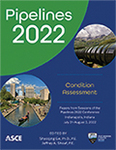Diagnosing and Quantifying Post-Disaster Pipe Material Cost Fluctuations
Publication: Pipelines 2022
ABSTRACT
Natural hazards pose significant threats to the integrity of pipeline networks. Rapid post-disaster reconstruction is crucial for both the safety and survival of communities. However, sudden increases in reconstruction costs following natural hazards often hamper the rapid reconstruction and rehabilitation of pipeline networks. It is essential to investigate the post-disaster fluctuations in pipe costs for a timely reconstruction of pipeline networks. The objective of this research is to quantify the pipe cost fluctuations after the 2021 Texas winter storm using cumulative sum control charts and seasonal autoregressive integrated moving average (SARIMA). The results indicate that the disaster triggered statistically significant increases in pipe costs, including corrugated steel pipe costs, polyvinyl-chloride (PVC) pipe costs, ductile-iron pipe costs, and copper water tubing pipe costs. The findings of this research can assist reconstruction engineers and capital planners in quantifying post-disaster cost fluctuations, identifying vulnerable pipe costs to disasters, and enhancing pipeline reconstruction plans.
Get full access to this article
View all available purchase options and get full access to this chapter.
REFERENCES
Ahmadi, N., and Shahandashti, M. (2020). Characterizing Construction Demand Surge Using Spatial Panel Data Models. Natural Hazards Review, 21(2), 04020008.
Ahmadi, N., and Shahandashti, S. M. (2018). Role of Predisaster Construction Market Conditions in Influencing Postdisaster Demand Surge. Natural Hazards Review, 19(3), 04018010.
Baek, M., and Ashuri, B. (2018). Profile monitoring for examining impact of Hurricane Katrina and Rita on highway construction cost. Transportation research record, 2672(51), 79–87.
Balaei, B., Wilkinson, S., Potangaroa, R., Adamson, C., and Alavi-Shoshtari, M. (2019). Social factors affecting water supply resilience to disasters. International Journal of Disaster Risk Reduction, 37, 101187.
Billings, S. B., Gallagher, E., and Ricketts, L. (2019). Let the rich be flooded: The unequal impact of hurricane Harvey on household debt. Available at SSRN 3396611.
Brusentsev, V., and Vroman, W. (2017). Disasters in the United States: frequency, costs, and compensation. WE Upjohn Institute.
Chang, S. E. (2016). Socioeconomic impacts of infrastructure disruptions. In Oxford research encyclopedia of natural hazard science.
Chen, H., and Huang, C. (2014). The use of a CUSUM residual chart to monitor respiratory syndromic data. IIE Transactions, 46(8), 790–797.
Esfahani, N. A., and Shahandashti, M. (2020). Post-hazard labor wage fluctuations: a comparative empirical analysis among different sub-sectors of the US construction sector. Journal of Financial Management of Property and Construction.
Girgin, S., and Krausmann, E. (2016). Historical analysis of US onshore hazardous liquid pipeline accidents triggered by natural hazards. Journal of Loss Prevention in the Process Industries, 40, 578–590.
Khodahemmati, N., and Shahandashti, M. (2020). Diagnosis and quantification of postdisaster construction material cost fluctuations. Natural Hazards Review, 21(3), 04020019.
Kim, S., Abediniangerabi, B., and Shahandashti, M. (2020). Forecasting Pipeline Construction Costs Using Time Series Methods. In Pipelines 2020 (pp. 198–209). Reston, VA: American Society of Civil Engineers.
Kim, S., Abediniangerabi, B., and Shahandashti, M. (2021a). Forecasting Pipeline Construction Costs Using Recurrent Neural Networks. In Pipelines 2021 (pp. 325–335).
Kim, S., Abediniangerabi, B., and Shahandashti, M. (2021b). Pipeline Construction Cost Forecasting Using Multivariate Time Series Methods. Journal of Pipeline Systems Engineering and Practice, 12(3), 04021026.
Kim, S., Choi, C. Y., Shahandashti, M., and Ryu, K. R. (2022). Improving Accuracy in Predicting City-Level Construction Cost Indices by Combining Linear ARIMA and Nonlinear ANNs. Journal of Management in Engineering, 38(2), 04021093.
Nejat, A., Brokopp Binder, S., Greer, A., and Jamali, M. (2018). Demographics and the Dynamics of Recovery: A Latent Class Analysis of Disaster Recovery Priorities after the 2013 Moore, Oklahoma Tornado. International Journal of Mass Emergencies and Disasters, 36(1).
Olsen, A. H. (2012). Demand surge following earthquakes. In 15th World conference on earthquake engineering (15WCEE), Lisbon, Portugal.
Psyrras, N. K., and Sextos, A. G. (2018). Safety of buried steel natural gas pipelines under earthquake-induced ground shaking: A review. Soil Dynamics and Earthquake Engineering, 106, 254–277.
Ward, P. J., Blauhut, V., Bloemendaal, N., Daniell, J. E., Ruiter, M. C. D., Duncan, M. J., … and Winsemius, H. C. (2020). Natural hazard risk assessments at the global scale. Natural Hazards and Earth System Sciences, 20(4), 1069–1096.
Zhou, Z., Gong, J., Roda, A., and Farrag, K. (2016). Multiresolution change analysis framework for postdisaster assessment of natural gas pipeline risk. Transportation research record, 2595(1), 29–39.
Information & Authors
Information
Published In
History
Published online: Jul 28, 2022
Authors
Metrics & Citations
Metrics
Citations
Download citation
If you have the appropriate software installed, you can download article citation data to the citation manager of your choice. Simply select your manager software from the list below and click Download.
